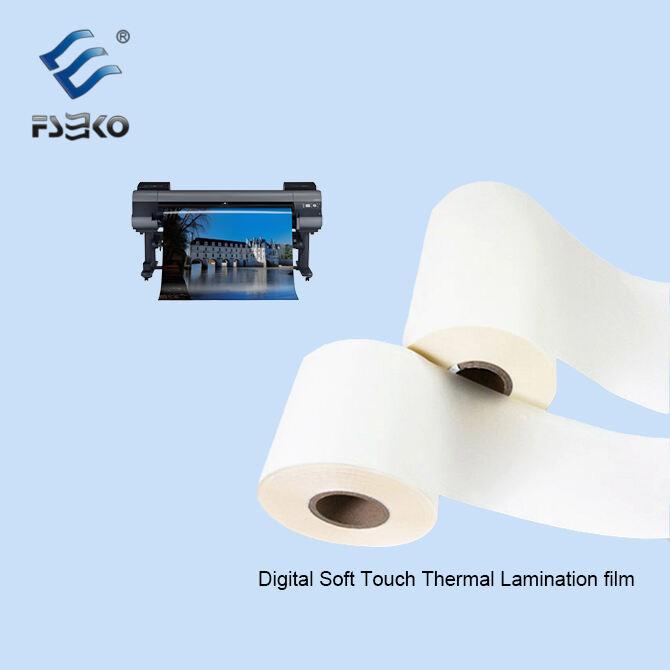Raqamli transformatsiya davrida turli sohalarda chidamli va yuqori samarali bosma materiallarga bo'lgan talab keskin oshdi. Lyuks pardaqlashdan tortib, moslashuvchan elektronikagacha bo'lgan sohalarda korxonalar bosilgan sirtlarni xiralash, ishqalanish va atrof-muhit ta'siridan himoya qilish hamda tashqi ko'rinishni saqlash imkonini beradigan yechimlarni qidirmoqda. Bu esa bizni muhim savolga yetaklaydi: Raqamli xiralishdan himoya qiluvchi plyonka haqiqatan ham o'z va'dalarini bajarmi? Uni innovatsiya hamda amaliy samaradorlik nuqtai nazaridan o'rganamiz, uning texnologiyasi, qo'llanilishi va samaradorligini ko'rib chiqamiz.
Raqamli Xiralishdan Himoya Qiluvchi Plyonkani Tushunish: Chidamlilik Orqali Ilmiy Asos
Digital chizilishga chidamli plyonka — bosilgan materiallarni jismoniy shikastlanishdan himoya qilish uchun mo'ljallangan issiqlik laminatsiya plyonkasining maxsus turi. Oddiy laminatlar bilan solishtirganda, bu plyonkalar chizilish, barmoq izlari va kimyoviy ta'sirlarga chidamli bo'lgan ilg'or polimer qoplam yoki qattiq sirt qatlami bilan ta'minlangan. Bu plyonkalar qattiklik hamda moslashuvchanlikni muvozanatlash uchun ishlab chiqilgan bo'lib, qattiq hamda egri substratlarga mos keladi.
Chizilishga chidamlilikning asosiy komponentlari :
- Qattiq qoplamlar : Ba'zi plyonkalarda sirpanishlarga qarshi to'siq vazifasini bajaradigan (odatda kremniy asosli yoki akrilik) shaffof, giperqattiq yuqori qatlam mavjud.
- Kuchaytirilgan polimerlar : Plyonkaning molekulyar tuzilmasi yorilish yoki qobiq chiqish ehtimolini kamaytirish uchun bog'lanish mustahkamligini oshirish maqsadida o'zgartirilishi mumkin.
- Ultrabinafsha barqarorlashtirish : Tashqi foydalanish uchun chizilishga chidamli plyonkalarga quyosh nurlarida sarg'ayish yoki degradatsiyani oldini olish uchun ultrabinafsha inhibitorlari kiritilishi mumkin.
Guangdong EKO Film Manufacture Co., Ltd. kabi sanoat yetakchilari ushbu xususiyatlarni optimallashtirish uchun o'ttiz yildan ortiq R&D tajribasidan foydalanadi. Masalan, ularning raqamli issiq laminatsiya plyonkalariga chizilishga chidamli, balki bosma ranglarining aniqqligini va qayta ishlash imkoniyatini buzmasdan nanoqo'shimchalar integratsiya etilgan.
Sanoatdagi qo'llanilishi: Qayerda a'lo bajariladi?
Raqamli chizilishga chidamli plyonkaning ko'p jihatdan qo'llanilishi sirt himoyasining muhim bo'lgan sohalarda zarur mahsulotdir:
- Bog'liq paketlash : Yuqori darajadagi brendlar kosmetika, zargarlik buyumlari va yuqori sifatli tovarlarning yetkazib berish hamda namoyish qilish davrida dastlabki ko'rinishini saqlash uchun chizilishga chidamli plyonkalarga tayanadi.
- Elektronika : Sensor ekranlar, qurilmalar korpuslari va boshqaruv paneli kundalik foydalanish natijasida vujudga keladigan chizilishlarga chidamli, shu bilan birga sensorli tekshirish funksiyasini qo'llab-quvvatlaydigan plyonkalardan foydalanadi.
- Tashqi belgilar : Reklama panolar yoki avtomashina paketlaridagi ob-havo ta'siriga uchraydigan raqamli bosmalar chizilishga chidamli hamda ultrabinafsha nurlanishga chidamli bo'lishi kerak.
- Moslashuvchan qadoqlash oziq-ovqat va farmatsevtika mahsulotlari uchun plastik bo'lmagan, xiralmas alternativlar barqarorlik va mahsulot xavfsizligiga e'tibor qaratayotgan brendlar orasida o'sib bormoqda.
EKO mahsulot portfelining moslashuvchanligi shunday namoyon bo'ladi. Ularning DTF (Direct-to-Film) issiqlik bilan laminatsiyalash filmi va plastik bo'lmagan issiqlik bilan laminatsiyalash echimlari raqamli bosmaxonadan ekalogiya to'plamlarigacha bo'lgan turli ehtiyojlarga xizmat ko'rsatadi va turli asoslar hamda bosma texnologiyalari bilan mos kelishini ta'minlaydi.
Haqiqatan Ham Ishlaydimi? Natijalarni Baholash
Xiralmas film samaradorligi quyidagi uch omilga bog'liq: material tarkibi, qo'llash jarayoni va foydalanish sharoiti .
- Laboratoriya sinovi : Ishlab chiqaruvchilar filmlarni Taber abraziv sinovi (tashlanishga chidamlilikni o'lchaydi) yoki qalam qattiqligi bahosi (masalan, xiralishga chidamlilik uchun 3H–6H) kabi qattiq sinovlarga beradi.
- Amaliy Fikrlar : Elektronika va avtomotot sohasidagi mijozlar sifatli plyonkalar bosilgan komponentlarning yashash muddatini uzaytirish orqali almashtirish xarajatlarini kamaytirishini aytishadi. Masalan, EKOning raqamli issiq plombirovka plyonkasidan foydalangan smartfon ishlab chiqaruvchi korxona ekran himoya qoplamlarining chizilish tufayli qaytarilish darajasini 40% ga kamaytirgan.
- Eko-taraqqiyot imkoniyati : Zamonaviy chizilmaydigan plyonkalar, jumladan, EKOning qayta ishlanadigan kompozitlari, ishlash sifatini pasaytirmasdan plastikni kamaytirish maqsadiga erishadi — ekologik jihatdan javobgar iste'molchilarga yo'naltirilgan brendlarga katta yutuq.
To'g'ri Plyonkani Tanlash: Asosiy Omillar
Barcha chizilmaydigan plyonkalar bir xil emas. Yetkazib beruvchini tanlashda quyidagilarga e'tibor bering:
- SERTIFIKATLAR : Global me'yoriy talablarga rioya etilishini ta'minlash uchun ISO standartlari yoki ekologik belgilar (masalan, RoHS, REACH) mavjudligini tekshiring.
- Moslashtirish : Ishlab chiqaruvchi sizning maxsus ehtiyojlaringizga moslashtirilgan plyonkalar taklif eta oladimi, masalan, mat/uzukli yuzasi yoki yorug'lik aks etishini kamaytiruvchi xususiyatlari?
- Texnik yordam : EKO kabi hamkorlar ilova qilishdagi qiyinchiliklarni hal etish uchun tadqiqot-ishtirok dasturlari va sotuvdan keyingi yordam ko'rsatadi.
Xizibga chidamli materiallarning kelajagi
Sanoatlar aqlliroq, ekologik yechimlarni talab qilayotgan sari raqamli xizibdan himoya qiluvchi plyonkalar ham rivojlanib bormoqda. Quyidagilar kabi yangilanishlar — o'zini tiklovchi qoplamalar (issiq yoki yorug'lik ta'sirida maydaroq xiziblarni tuzatadi) va biologik jihatdan parchalanadigan qattiq qatlamlar yaqin ormanda. O'z portfeliga mahalliy hamda xalqaro patentlarni kiritgan EKO kabi ilmiy-tadqiqot ishlariga sarmoya kiritayotgan kompaniyalar ushbu o'zgarishni boshqaradi, natijada samaradorlik hamda barqarorlikni oshiradi.
Xulosa
Raqamli xizibdan himoya qiluvchi plyonka — faqat marketing nishon emas, balki materialshunoslik hamda amaliy tekshiruvlar bilan tasdiqlangan ishonchli texnologiyadir. Brendingizning vizual butunligini saqlash, chiqindilarni kamaytirish hamda iste'molchilarning kutganlarini qondirish uchun bizneslar sifatli plyonkalarga sarmoya kiritishi strategik zaruratdir. Guangdong EKO Film Manufacture Co., Ltd. kabi innovatorlar bilan hamkorlik qilish orqali siz raqamli davrda chidamlilikni qayta belgilovchi zamonaviy materiallarga ega bo'lasiz.
Sizning sohangizga moslashtirilgan xiralardan himoya qiluvchi yechimlarni o'rganish tayyormisiz? Yuqori sifatli sirtlarni himoya qilish yo'li noyob qiyinchiliklaringizni tushunish bilan boshlanadi — va ularni hal etuvchi fan bilan.


